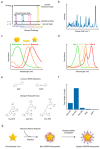Advances in Surface Enhanced Raman Spectroscopy for in Vivo Imaging in Oncology
- PMID: 34976579
- PMCID: PMC8671959
- DOI: 10.7150/ntno.62970
Advances in Surface Enhanced Raman Spectroscopy for in Vivo Imaging in Oncology
Abstract
In the last two decades, the application of surface enhanced Raman scattering (SERS) nanoparticles for preclinical cancer imaging has attracted increasing attention. Raman imaging with SERS nanoparticles offers unparalleled sensitivity, providing a platform for molecular targeting, and granting multiplexed and multimodal imaging capabilities. Recent progress has been facilitated not only by the optimization of the SERS contrast agents themselves, but also by the developments in Raman imaging approaches and instrumentation. In this article, we review the principles of Raman scattering and SERS, present advances in Raman instrumentation specific to cancer imaging, and discuss the biological means of ensuring selective in vivo uptake of SERS contrast agents for targeted, multiplexed, and multimodal imaging applications. We offer our perspective on areas that must be addressed in order to facilitate the clinical translation of SERS contrast agents for in vivo imaging in oncology.
© The author(s).
Conflict of interest statement
Competing Interests: The authors have declared that no competing interest exists.
Figures






Similar articles
-
Noninvasive and Highly Multiplexed Five-Color Tumor Imaging of Multicore Near-Infrared Resonant Surface-Enhanced Raman Nanoparticles In Vivo.ACS Nano. 2021 Dec 28;15(12):19956-19969. doi: 10.1021/acsnano.1c07470. Epub 2021 Nov 19. ACS Nano. 2021. PMID: 34797988 Free PMC article.
-
Surface-Enhanced Raman Spectroscopy: A New Modality for Cancer Imaging.J Nucl Med. 2015 Sep;56(9):1295-9. doi: 10.2967/jnumed.115.158196. Epub 2015 Jul 16. J Nucl Med. 2015. PMID: 26182971 Free PMC article. Review.
-
Multiplexed imaging of surface enhanced Raman scattering nanotags in living mice using noninvasive Raman spectroscopy.Proc Natl Acad Sci U S A. 2009 Aug 11;106(32):13511-6. doi: 10.1073/pnas.0813327106. Epub 2009 Jul 28. Proc Natl Acad Sci U S A. 2009. PMID: 19666578 Free PMC article.
-
Multiplexed Liquid Biopsy and Tumor Imaging Using Surface-Enhanced Raman Scattering.Biosensors (Basel). 2021 Nov 12;11(11):449. doi: 10.3390/bios11110449. Biosensors (Basel). 2021. PMID: 34821665 Free PMC article. Review.
-
Recent advances in applications of nanoparticles in SERS in vivo imaging.Wiley Interdiscip Rev Nanomed Nanobiotechnol. 2021 Mar;13(2):e1672. doi: 10.1002/wnan.1672. Epub 2020 Oct 18. Wiley Interdiscip Rev Nanomed Nanobiotechnol. 2021. PMID: 33073511 Review.
Cited by
-
Environmental protection based on the nanobiosensing of bacterial lipopolysaccharides (LPSs): material and method overview.RSC Adv. 2022 Mar 28;12(16):9704-9724. doi: 10.1039/d1ra09393b. eCollection 2022 Mar 25. RSC Adv. 2022. PMID: 35424904 Free PMC article. Review.
-
Nanoparticle Uptake in the Aging and Oncogenic Drosophila Midgut Measured with Surface-Enhanced Raman Spectroscopy.Cells. 2024 Aug 13;13(16):1344. doi: 10.3390/cells13161344. Cells. 2024. PMID: 39195234 Free PMC article.
-
Synergies in antimicrobial treatment by a levofloxacin-loaded halloysite and gold nanoparticles with a conjugation to a cell-penetrating peptide.Nanoscale Adv. 2022 Sep 15;4(20):4418-4433. doi: 10.1039/d2na00431c. eCollection 2022 Oct 11. Nanoscale Adv. 2022. PMID: 36321152 Free PMC article.
-
Engineered aptamers for molecular imaging.Chem Sci. 2023 Nov 21;14(48):14039-14061. doi: 10.1039/d3sc03989g. eCollection 2023 Dec 13. Chem Sci. 2023. PMID: 38098720 Free PMC article. Review.
-
In vivo imaging using surface enhanced spatially offset raman spectroscopy (SESORS): balancing sampling frequency to improve overall image acquisition.Npj Imaging. 2024;2(1):7. doi: 10.1038/s44303-024-00011-9. Epub 2024 Apr 3. Npj Imaging. 2024. PMID: 38939049 Free PMC article.
References
-
- Moriyasu F, Itoh K. Efficacy of perflubutane microbubble-enhanced ultrasound in the characterization and detection of focal liver lesions: phase 3 multicenter clinical trial. American Journal of Roentgenology. 2009;193:86–95. - PubMed
-
- Smeenge M, Tranquart F, Mannaerts CK, de Reijke TM, van de Vijver MJ, Laguna MP. et al. First-in-Human Ultrasound Molecular Imaging With a VEGFR2-Specific Ultrasound Molecular Contrast Agent (BR55) in Prostate Cancer: A Safety and Feasibility Pilot Study. Invest Radiol. 2017;52:419–27. - PubMed
Publication types
MeSH terms
Substances
Grants and funding
LinkOut - more resources
Full Text Sources
Medical
Miscellaneous

